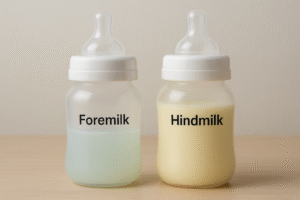Breast milk can sometimes appear with a faint green tint — a surprise for many new moms. Don’t panic! In most cases, this soft green hue is completely normal and related to diet or nutrient content. This guide will help you understand what causes a greenish tint in breast milk, when it’s harmless, and when it may signal a storage or health issue.
Understanding the Green Tint in Breast Milk
If your milk looks slightly green (not bright or dark), it usually reflects pigments from the food you’ve eaten or supplements you’re taking. U.S. lactation experts confirm that natural color variations are common and don’t affect your milk’s safety or nutrition.
Common reasons include:
- Eating spinach, kale, broccoli, or green smoothies
- Taking iron or chlorophyll supplements
- Small oxidation during storage (especially in refrigerated milk)
👉 Learn more about broader milk color meanings in our guide on What Color Should Breast Milk Be?
Diet-Related Causes of Green-Tinted Milk

Your diet has a direct impact on breast milk color. Consuming leafy greens or foods with artificial coloring (like matcha lattes or green protein shakes) can easily give your milk a soft green hue.
This happens because carotenoids and plant-based chlorophyll pigments mix with milk fats. It’s harmless and even reflects nutrient richness.
According to La Leche League International, pigment-related color shifts are common among moms who eat a plant-heavy diet.
Storage Factors and Light Exposure

Sometimes, milk that looks white when freshly pumped may develop a greenish tint after refrigeration.
This occurs due to oxidation — a natural reaction when milk fats interact with air or light exposure.
To prevent this:
- Store milk in opaque or shaded containers
- Keep it sealed tightly to limit air contact
- Maintain temperature consistency (below 40°F / 4°C)
For detailed storage instructions, check our article Breast Milk Storage: Complete U.S. Mom’s Guide (2025 Edition).
When to Be Concerned
A faint green tint is usually harmless. However, contact your healthcare provider if:
- The milk has a strong foul odor (not soapy or metallic)
- Your baby refuses the milk repeatedly
- The color deepens or appears uneven (patchy or clotted)
Sometimes a greenish tint can occur from trace blood or infection, though this is rare.
If in doubt, store a small sample and consult a lactation consultant for review.
Safe Feeding and Handling Tips
- Always swirl (don’t shake) the milk to mix separated fat.
- Label and date each container before freezing.
- Avoid mixing fresh milk directly with older milk.
- Follow CDC’s U.S. Breast Milk Storage Safety Guidelines for optimal freshness.
💡 Extra Tip: If your milk has a mild green tint after thawing frozen milk, it’s likely due to oxidation — still safe if it smells normal.
FAQ: Green-Tinted Breast Milk
Q1: Is green-tinted breast milk safe for my baby?
Yes, it’s completely safe in most cases. The color is typically from diet or supplements.
Q2: Does spinach or kale make breast milk green?
Absolutely. Green vegetables are the most common cause of light green milk.
Q3: Should I stop taking my green smoothie or chlorophyll supplements?
Not necessarily. As long as your baby feeds normally and the milk smells fresh, you can continue.
Q4: Can frozen milk turn green?
Yes, oxidation can cause mild color changes. Proper sealing and freezer-safe bags minimize this.
Conclusion
A subtle green tint in your breast milk is usually nothing to worry about — it’s a sign of nutrient-rich milk influenced by your diet. By storing milk safely and understanding natural color variations, you can confidently continue feeding your baby without concern.
If you notice persistent color or smell changes, consult your lactation consultant for peace of mind.
For more guidance on milk freshness, check out our detailed post How to Tell If Frozen Breast Milk Is Bad (U.S. Moms’ Guide).











